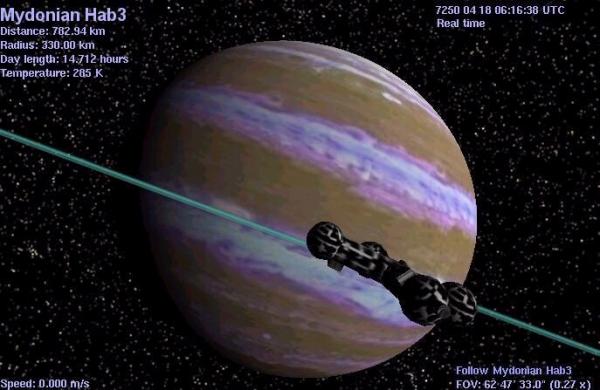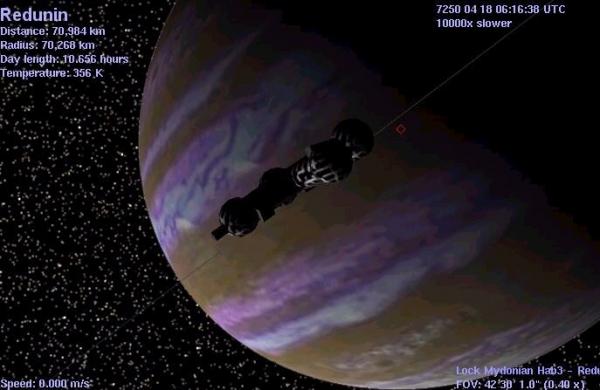BY LETTER
Hiederia
Galactography > Regions of Space > Outer Volumes
Galactography > Sephirotic Empires > Solar Dominion
Galactography > Systems and Worlds > Systems & Worlds G - H
Galactography > Sephirotic Empires > Solar Dominion
Galactography > Systems and Worlds > Systems & Worlds G - H
 Image from Steve Bowers | |
| Mydonian Habitat orbiting Redunin | |
Hiederia (Redunin system) Data Panel | |
| Star | Hiederia |
|---|---|
| Distance from Sol | 3618 light years |
| Stellar Type | M0V red dwarf |
| Allegiance | Solar Dominion and Independant postneumann 'Mydonian Evolution' |
History
In the Perseus Rift, Outer Volumes, is the relatively minor star system of Hiederia.In 8614 a Solar Dominion exploration fleet discovered an unassuming Red Dwarf with an epistellar Jovian, a scattered asteroid belt, single airless rockball world, an icy failed core, and a diffuse comet halo. Deducing the system - named Hiederia after a popular (at the time) exhibition by a Solar Dominion Perfect Artist - would be useful as a staging post to the outer volumes Perseus rift periphery, the governing Prefect, the Most High (SI:3) transapient Ab-Ramon-Urlon, in keeping with the perceived will of the Lord of Rays, dispatched a linelayer to connect Hiederia to the Nexus
Unfortunately, on arrival in 8746, it was found that the jovian had been colonised by a high level postneumann civilization. The SI:1.4 linelayer Borde's Glory XXIV found emself seriously outclassed (transavant simulations showed the postneumanns were of middle to high second toposophic rating. The Ship AI squirted a report of the new situation back down the wormhole, and it was decided to send a high SI:2 partial emulation (all that could be arranged given the low bandwidth of the nanogauge WH guide) to open negotiations.
The postneumanns - who identified themselves as the "Mydonian Evolution" - were seen to be non-hostile, and not affiliated with any of the major ahuman hyperpolities or metacivilizations, and had established themselves in and around a number of epistellar jovians in the region, where they had set up Deep Well Industrial Zones as well as high temperature computronium bands.
Over the next 2 standard years negotiations continued (mostly at a very slow pace because of the low WH bandwidth), and it was agreed that the Mydonians would keep the epistellar jovian, two thirds of the stellar output, and half the asteroid belt. The rest of the system would be ceded to the Solar Dominion, or left fallow. Borde's Glory XXIV with her precious wormhole cargo was redirected to a nearby uninhabited system, which was named New Jamis.
Over the next few centuries, a lucrative trade and cultural; exchange deal was opened with the Mydonians, some Zars invested in and created a set of interesting habitats out of asteroids and comets, at least two dozen distinct clades, including exotic tweaks, cyborgs, and cold-temperature xenos called Epp (see Pluton Volume) established colonies in the system, and the wisdom of the Lord of Rays applauded for this new outcome which added to the diversity and interest of the Empire
Hiederia Today
Today the system consists of:Hiederia Prime - a red dwarf, incorporating sun-mining faculties by both the Dominion and the Mydonian Evolution, as well as large-scale solar arrays and amat farms.
 Image from Steve Bowers |
Redunin - the Jovian, which has been extensively modified by the Mydonians, and is surrounded by megastructure belts and habitats on which a number of client cyborg and vec clades can be found, as well as ship docks and computronium ISOs, and a Dominion trade delegation. The SI:2 rated Mydonian produce cannot be used by lower toposophics, but has a strange mechanical beauty to it, and even cast-offs are in high demand as curios.
The belt has long since been converted into habitats, or used as raw resources by one or the other of the local polities.
Most spectacular are the Dominion habitats, each owned and custom-built by a single Zar (most are superiors, although there is a single large transapient's hab). These vary in diameter from several hundred to over a thousand kilometers, may be rings, squat cylinders, spheres, or fractal like forms, and contain beautiful parkland, forests and waterfalls, tropical beaches, snow capped mountains, amazing architecture, temples, art galleries, palaces, and more, and slaved hyperturing partial angelnetting. Sometimes a zar will entertain by inviting guests from a nearby system like Hybernica or New Jamis (the relativist journey is not excessive), although other times the habs will be vacant for decades or centuries, maintained by subturing bots or (occasionally) neophytes hoping for Zarhood.
The other habs and megastructures are more populated. Some are extreme environments, or bot worlds, or lower grade utopias and autotopias, or - in the case of the slumworlds like Doywin and Nadsarbat, have become homes to poorer bionts, anti-sephirotic hu supremacists, ferals, middle tech refugees from blights or ahumans, and others who wanted to go somewhere better but ended up here instead.
 Image from Steve Bowers | |
| The Metasoft fractal Chrome Boxworld is a spectacular near-freefall habitat; this structure has a very low intrinsic gravity througout | |
There are also a number of fairly prosperous trade habitat-polities, data-havens, legal-havens, and a spectacular 2800 km fractal Metasoft-affiliated vec world called Chrome Boxworlds.
Finally there is the important waystation of Garibald; Garibald Spaceport is the largest in the system, and most outsystem ships stop here first.
A lot further out is a small paraterraformed rockworld and open societeum called Barisch, home to no less than 259 distinct biont and cyborg clades and polities, along with arcologies, parks, deserts, extreme sports theatres, and - at any one time - at least one low scale / limited brushfire war or skirmish. The governing SI:2 transapient, called "Big Barisch", ensures that no wars escalate to damage the planetary environment or ultratech infrastructure (nukes, khaki goo, and amat weapons are strictly forbidden), and all participants have to sign a disclaimer stating that they are aware that involvement may be dangerous to their health (back-up facilities are available but not everyone uses them, as some clades are paranoid of transapients). Barisch is extremely popular with Dominion and other sephirotic extreme sportists and real life wargamers. The world is served by several beanpoles, at the end of which are spaceports and small habitats.
The last world in the system is the failed microjovian iceworld of Grishelda, which is home to a number of cold-adapted terragen and xeno clades and exotics, and is even a local center of cryoarts and culture, and is surrounded by a number of orbital bradymetabolic- inhabited market-worldlets. Often one finds here transient ferals who take advantage of the authorities' tolerance and slow response times to set up arctic-proof microhabs for a while, hoping for a lift offsystem, or time and resources to restore their failing ships.
Finally there is the comet cloud, or what is left of it. This is populated by the usual cold-adjusted clades, and low energy haloists, snowflakers, and some sloppy hiders.
Related Articles
Appears in Topics
Development Notes
Text by M. Alan Kazlev
Initially published on 17 November 2004.
Initially published on 17 November 2004.






